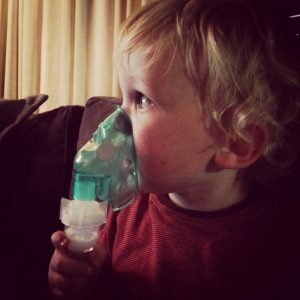Humid inhalers, so-called nebulizers, produce the finest droplets of a saline solution that can penetrate into the narrowest airways of even the smallest of patients. Isotonic or physiological saline solutions have the same salt concentration as human body cells. By moistening the airways, they support the lungs’ self-cleaning mechanism and prevent infections.
In acute cases, inhalation with a higher percentage saline solution helps (three percent is best for children in the field of self-medication). Like a vinaigrette from a lettuce leaf, the salt draws water from the mucous membrane of the respiratory tract, which is swollen when infected. It swells. At the same time, the water thins the mucus so that it can be removed more easily. In this way, moist inhalation helps clear the airways, for example in the case of a cold or asthma.
Nebulizer For Kids

The solutions are obtained in portions in 2.5-milliliter ampoules in the pharmacy. Saline solution also serves as a carrier for bronchodilator drugs, as prescribed by pediatricians for bronchitis and especially for asthma. In this way, the drug arrives at the right place of action. The dose and side effects remain so low. Another advantage of the nebulizer: the children do not have to consciously breathe firmly. The droplets still reach the narrowest parts of the child’s lungs. Devices suitable for babies produce the smallest droplets.
A simple steam bath, on the other hand, produces droplets ten times larger than a nebulizer. Dissolved substances such as table salt do not evaporate with them. In addition, large droplets get stuck in the nasal cavity and throat. Incidentally, unlike a steam bath, there is no risk of scalding with a nebulizer. But be careful: cough syrup, tea, or essential oil clog or stick the filigree technology and do not belong in the nebulizer.
Three types of nebulizers. Jet nebulizers with a compressor are the most common. You press the solution through a nozzle with compressed air and thus atomize the liquid. Mesh and ultrasonic nebulizers work more quietly and are more manageable, sometimes faster. Ideal for sick people who are particularly sensitive to noise, impatient rascals, or for on the go.
How Nebulizers Work
Depending on the type of nebulizer, a session lasts three to ten minutes. In order to sweeten the duration of the inhalation for children, experts recommend combining positive experiences with inhalation. If, for example, your favorite cuddly toy shows you how inhalation works, things are much better right away. The correct breathing technique can also be learned through play. Important: breathe calmly and evenly and take a break after inhaling and exhaling. This works best in an upright, relaxed position. Inhalation for babies is made easier with a cuddly mouth and nose mask. An elbow makes it possible to hold the nebulizer straight, even when the child is lying down. At around three years of age, children can change a conventional mouthpiece. Parents can get useful helpers from the pharmacy if necessary – sometimes as loan devices. With a prescription from the doctor, the health insurance company fully reimburses the cost of some devices for children.
